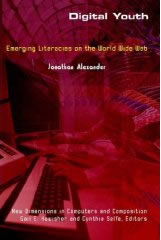Alexander, Jonathan (2006). Digital Youth: Emerging Literacies on the World Wide Web. Cresskill, NJ: Hampton Press, Inc.

Reviewed by Meredith Graupner
Overview
Contrary to research that explores how youth are affected by using technologies, this text examines the digital literacies youth are already engaging in online. Jonathan Alexander argues that by paying attention to digital youth and their literacy practices we can learn about the knowledge students bring to the composition classroom. Though this text does not attempt to exhaust all digital literacy practices, it provides a unique look at personal websites, informational websites, electronic magazines (e-zines), and activist websites created and maintained by this generation. By analyzing these online environments, Alexander argues that “we are seeing more of a blending of traditional and electronically enabled literacy and composition practices” (p. 385). Such a claim can serve to lessen some concerns that digital youth are losing the ability to communicate effectively through traditional literacy practices.
Literacy Possibilities—And Problems
In “Literacy Possibilities—And Problems,” the first of three parts, Alexander participates in the on-going discussion about how literacies are gained and lost through the “digital revolution.” From his perspective, the main difficulty of speculating what is lost or gained lies in our inability to project how a generation of individuals will grow up in a non-print culture. He ends chapter one by noting that it is too early to define which side is right on the debate of literacy practices and we should instead look for ways to pay attention to the “motion” of literacy (p. 64). Chapter two extends the argument further by critiquing the research of “techno-realist” Douglas Rushkoff and concludes that utopian views of digital youth subcultures should be met with trepidation because students may not be critically consuming web-based material.
Literacy Practices
In “Literacy Practices” Alexander explains how the relationships between authors and readers are re-shaped through personal homepages, e-zines, and queer sites created and maintained by digital youth. Though traditional literature suggests that only certain versions of one’s identity are portrayed through personal homepages, chapter three reveals that homepages are more than that. Homepages are complex hybrids of self-expression and emancipation that become further complicated by how online communities are defined.
Recognizing that it is extremely difficult to understand how the web broadly affects “digital youths’ ‘conception of both community and identity,’” Alexander focuses specifically on electronic magazines (e-zines) in chapter four to provide a “glimpse” into these literacy practices. Contrary to more commercial e-zines that expect readers to take action, digital youth use e-zines as a means for disseminating ideas that simply raise awareness.
To elaborate further on how web sites function among commercials sites that claim to address the needs of digital youth, chapter five explains a case study of “home-grown” queer sites, ones that do not have inherently commercial motives, and attempts to answer to the following question: “[a]re the images and representations [created for and by queer youth] comparable, or do they offer us different understandings of queer digital youth and their interests, ideas, and sociopolitical investments with regard to queer sexuality?” (p. 231). In this case Alexander concludes that queer youth distinguish themselves from “coming out” sites, or sites offering support for those without in-real-life (IRL) communities.
Activist Literacies
Part three addresses how digital youth use the web to inspire change through activism. In chapter six Alexander reiterates that youth use the web as a tool for critiquing the activist medium. From his perspective, the web acts as more of a “supplement” to activism than a sole act of activism itself. This is mainly the result of the expansive nature of the web and the somewhat difficult task of targeting a specific audience (p. 319).
While chapter six focuses on a number of digital youth activist sites, chapter seven focuses narrowly on a web-based class project that gave first-year composition students the opportunity to experiment with their digital literacies as they learned to become proficient in academic discourse. Though the project had drawbacks stemming from its service-learning approach, Alexander considers it a success because, in this case, “the Web has become a place not just for the dissemination of information, but a site as well for both textual and visual activism and intervention” (p. 379).
Conclusions
Alexander’s research serves as a welcoming perspective for writing instructors who may be concerned with the ways in which their students’ digital literacy practices are affecting student writing in the classroom. He concludes Digital Youth by arguing that “[t]he coupling of writing for the Web with other kinds of literacy practices suggests that digital youth are not abandoning the pleasures and rigors of text as much as they are using—to their advantage—all of the media platforms available for crafting and disseminating their ideas” (p. 385). This conclusion not only puts instructors at ease, but also serves as a point for further research pertaining to how we actively incorporate both digital literacies and academic literacies in pedagogy that is mutually beneficial for students and teachers alike.